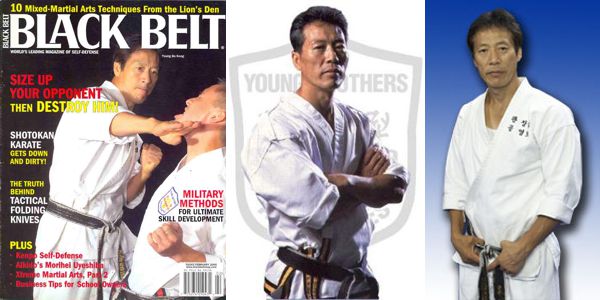Take Kwon Do Grand Master Young Bo Kong as spent a lifetime perfecting his skills in the ancient art of Korean hand and foot fighting. In his youth, Kong’s peers called him the fastest kicker in the world. Decades later he still delivers his techniques with blinding speed and devastating power. However, he is the first to admit that speed and power are only part of what it takes to become a solid black belt. Grand Master Kong believes that a well-rounded martial artist must also be able to effectively block an opponent with the intent of setting them or up for a powerful counter attack while taking away their ability to do the same.
“It is very important to understand the mechanics of the human body,” says Grand Master Kong. “To begin with you must be able to observe what you’re opponent is doing from head to toe. When you look at the person you are fighting don’t just look at their eyes or their hands or feet. You must watch the whole body and learn how not to be fooled by a faint or fake move.”
One of the basic principals this 2-time world champion fighter teaches his students is how to evade the power of an advasary’s attack. One method to accomplish this against a punch is to “back off” the attack, thus avoiding being drawn into a “sucker punch.”

“When someone punches don’t move forward into their attack,” says Grand Master Kong. “Avoid the maximum velocity of the attack by moving away from it. Never go forward. If you do move into block and they’re setting you up with a fake, you will run right into the power of their attack. Instead, lean back avoiding the punch. That way your opponent must commit with their next move and you can then counter, or if they hesitate, then you may move in with an attack of your own. Remember there is a big difference between leaning away from the attack and stepping backwards in a straight line. If you do step straight back it’s important to guide the blow down or block the attack to take your opponent off balance.”
Knowing how to use an opponents power in your favor is a tactic as old as the martial art itself. This maxim is the foundation for one of Grand Master Kong’s basic strategies when countering a power punch.
“In Tae Kwon Do we use the Ying and Yang principal,” says Grand Master Kong. “Never go against the power of an attackers punch or kick. You always block or move in the direction of your opponent’s flow of power. With this accomplished you have moved your attacker off center subsequently causing him or her to be off balance. Now the flow of power is now in your favor and you are also in a much stronger position to attack with a kick or punch.”
Sidestepping an attack is another basic but very important way to avoid a punch or kick. However, to maintain an effective striking distance to counter such an attack Grand Master Kong stress the importance of how to use angles.
“You don’t want to move back on a straight line,” says Grand Master Kong. “Going straight back without doing anything to change the direction of your opponents attack could set you up for a second technique. For example they may throw a front kick to move you backwards, in reality they have lined you up for a spinning back kick. Moving to the side will off set the power of your opponent’s attack and causes him to miss his target. It also gives you a good angle to counter attack from, and it’s also a good position in case you miss your block. In that case your opponent will generally be forced to back off and use a different attack.”
When defending against a sidekick Grand Master Kong says it is a mistake to block it by pushing the kick down. Because of the kicker’s momentum it is very easy for him to land the sidekick even if it has been pushed down. Another problem to be aware of is when you push the kick or punch down, your head may drop or you might look down making you vulnerable to a head attack. Grand Master Kong teaches this offensive maneuver as well.
“When I kick and only use my leg to generate power and distance it can fall short of the target,” says Grand Master Kong. “To get the most power and distance out of your kick you must use your hips. If you swing your hips into the kick you will have much more power. It is similar to Bruce Lee’s one-inch punch. The popping action of the hip will generate at least 30% more power.”
In addition, by merely extending or turning the hip into the kick you will get an extra inch or two of distance. This is more than enough extension for the edge of the foot or heel to drive into an opponent’s rib cage, even if they’ve “slapped” your initial kick.
Grand Master Kong went on to explain that by using the hip in this manner explains how someone who weighs 135 pounds can smash through 7-inches of boards. Conversely, this hip-generated power can be diminished if properly redirected.
“If the sidekick is pushed away, it will be ineffective,” says Grand Master Kong. “By brushing the kick to the outside or inside I am redirecting it, and I can also grab the ankle using a hooking grip, pull him off balance and counter with a punch or kick.”
According to Grand Master Kong, it is important to remember to “suck in” your body as you catch the kick. The sucking action goes in the direction of the kick’s flow of power while giving the defender an extra couple of inches of avoidance space.
“Once you’ve hooked the kick with your hand, pull your opponent toward you and attack with a backfist, a punch or a ridgehand strike,” explains Grand Master Kong. “Remember once you’ve pushed the kick away you must do one of two things immediately. Either rush inside the kick and attack, or grip and lock the leg so they cannot come up with a round house kick, then attack.”
Another effective way to redirect a punch or kick is to “slap” it down. This block must be done quickly and with sufficient power and follow through to force the attacking limb downward pulling the attacker’s balance forward. This action drags the attacker’s force directly into the path of the defender’s attack. The result can be devastating as the two human power plants collide with the force of one blow.
“Always go in the direction of the power,” says Grand Master Kong. “When you slap the punch or kick down attack quickly in the direction of their power because by pulling them forward, they’re energy will be used against them. So when you punch or kick them, the force will be twice as great.”
As Taekwon do stylists are known for their powerful arsenal of kicks, it’s important to know how to defend against them. Grand Master Kong likes to teach his students how to be in the proper position so that if they do miss the block, the attacker’s kick will at least be ineffective.
“If you block at kick and miss, it’s important to be in a position that makes the kick ineffective,” says Grand Master Kong. “In addition to using angles as I mentioned earlier, it’s also important to be able to avoid the kick completely. The round kick is executed with the same principle as the roundhouse punch so use the same concept to block it. I like to avoid, then catch it under the leg, push on the shoulders, block his other leg with my foot, and sweep him to the ground.”
Grand Master Kong went on to demonstrate how easy it is to take away a kickers balance by lifting the opponents leg enough to bring him or her onto the tip of their toes. With that accomplished taking them to the ground or countering with a kick can be done with relative ease.
“When you grab an opponents leg they will try to punch you,” says Grand Master Kong. “To avoid this merely lift the leg and that takes away their leverage so they cannot throw a punch.”
Another powerful kick to avoid is the back kick. Whether executed as a thrust kick or spinning, this lethal technique can easily injure, even kill. However like all techniques it has it weak points too. The Ying and Yang philosophy is a two way street, and if you know how to avoid this kick you’re walking on the Yang side of the avenue.
“The back kick is very powerful if done properly,” says Grand Master Kong. “It is most effective to stop someone who is charging you. The spinning back kick is often against someone who is backing up. However to avoid this kick merely use the same technique that you would to stop a sidekick. The “push away” method is very good. So is stepping off at an angle. However “jamming” this kick is not a good idea, nor is “slapping it down” a good idea. It’s best to step off to the outside of a back kick. You may move to the inside of the kick, but the timing must be perfect.”
Of all the techniques use in Taekwondo the hooking kick may be the most deadly and the most difficult to block. The whipping action of the foot can easily slip inside most high blocks, and to merely step away from the kick allows the attacker to change up to a round kick. To effectively stop the power of a hooking kick, the defender must first take away its momentum.
“The hook kick is very difficult to block,” says Grand Master Kong. “It is better to dodge it. If it comes through deeper than you expected, back off and wait for the next opportunity. Knowing how to judge the effective distance of a hook kick is very important. One way to counter it is to keep your feet stationary while leaning your body away from the kick. That way when the kick misses you are still in position to lunge forward and attack. The other way is to move into the kick and “jam” it before it reaches maximum velocity. This way you will take the power away from the kick before it has a chance to reach maximum force. When doing this, a counter leg sweep is a very effective technique.”
Working under the premise that the best offense is a good defense, Grand Master Kong explains the Ying and Yang of the roundhouse kick when used in a defensive posture.
“When you do the round house kick properly it can serve as both an offensive weapon and a defensive tool,” Grand Master Kong explained during a black belt training session. “If you bring your leg up straight and someone is moving in, the knee will block the attacker’s advance. Next you punch the attacker to set up your next attack.Then you execute a roundhouse kick or an ax or a hooking kick by simply twisting the hips. Instantly it goes from a blocking tool and it becomes a very powerful offensive weapon. It is important to remember however, if you do not assume a correct starting position the kick will fail in both regards.”
In addition to turning the blocking knee into a roundhouse kick, it can also be turned into a powerful sidekick, and hook kick. Grand Master Kong emphasis that proper positioning is imperative to get the maximum amount of speed out of your technique.
According to the faster kicker alive speed equals power and the foundation for this formula is based on a student’s ability to execute his or her techniques with surgical like precision. In other words, “practice makes perfect.”




